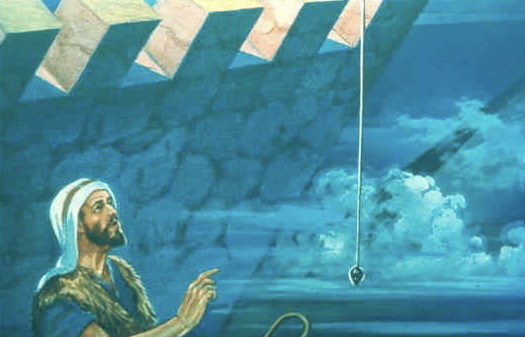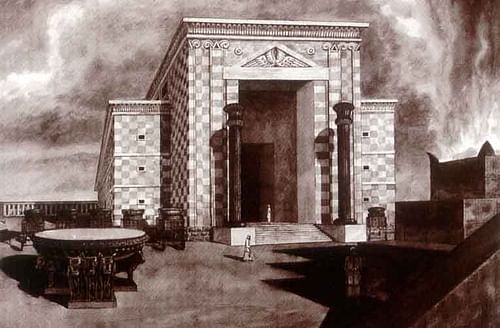This article is part of a series on Old Testament Christophanies. For important background information, see An Introduction to Old Testament Christophanies–with Justin Martyr.
Amos prophesied around 760–750 BC, during the reigns of King Uzziah of Judah and Jeroboam II, king of Israel. Amos was a herdsman and a grower of sycamore figs who lived in Tekoa, a village in Judah (Amos 1:1; 7:14). And while Amos wasn’t a prophet by profession, he was made one by the Lord (Amos 7:14–15). Amos was sent to announce God’s judgment on the northern kingdom of Israel for the nation’s idolatry and injustice. And included in the visions Amos was given were two appearances of the Son of God.
Standing Beside a Wall

In Amos 7, the prophet was given three visions that warned of God’s coming judgment on Israel. In the first vision, “Lord Yahweh” (Heb. Adonai YHWH) formed a swarm of locusts in the springtime, after the first crop had been harvested and when the second was beginning to sprout.[1] After Amos saw the locusts consume all the fresh vegetation, he asked “Lord Yahweh” to please forgive the nation or they wouldn’t survive, since “Jacob” (Israel) was so small. The Lord relented, telling Amos that the vision wouldn’t come to pass. In the second vision, “Lord Yahweh” summoned a fire so intense that it burned away the land’s underground reservoirs. As the fire began to burn away the farmland, Amos asked “Lord Yahweh” to stop. Amos asked how the nation could survive since “Jacob” was so small. The Lord again relented, telling Amos that this vision also wouldn’t come to pass (vv. 1–6).
In the first two visions, Amos saw what the Lord could have done. But in the third, Amos saw the Lord Himself as judge:
This is what he showed me: behold, the Lord was standing beside a wall built with a plumb line, with a plumb line in his hand (Amos 7:7 [ESV]).
The Lord Amos saw represented Yahweh, the One who was speaking to the prophet and giving him the vision. “Lord” here is translated from the Hebrew Adonai. The Lord may have been called Adonai to distinguish Him from the unseen Yahweh; thus, the shift from Adonai YHWH in verses 1–6 to Adonai here in verse 7. Because He was seen appearing as a man standing on the earth, the Lord beside (or upon) the wall was the Son of God (John 1:18; 6:46). The wall represented Israel as God intended the nation to be—perfectly straight. The Lord held a plumb line to symbolize that He would be judging Israel by His perfect standards.
Yahweh asked Amos what he saw, and the prophet answered that he saw a plumb line. Then, the Lord (Adonai) told Amos that He was about to put a plumb line in the midst of His people Israel, and that He would no longer spare them. The Lord further said that the high places of “Isaac” (Israel)[2] would be desolated, that the sanctuaries of Israel would be laid waste, and that He would then rise up against the house of Jeroboam with the sword (vv. 8–9). The Lord (Adonai) spoke and judged as only Yahweh could. The Lord would hold the plumb line in the midst of His people to demonstrate how badly misaligned the nation had become. The nation had become so misaligned that the Lord decided to tear it down. The Lord’s verdict on the nation soon came to pass. Jeroboam’s son Zechariah reigned over Israel for only six months before being assassinated by his successor Shallum, who was from another house (2 Kgs 15:8–10). And then a few decades later, in 722 BC, Samaria fell to the invading Assyrians and the people of Israel were exiled to Assyria (2 Kgs 17:6).
Standing Beside the Altar

In Amos 8, “Lord Yahweh” (Heb. Adonai YHWH) showed the prophet a vision of a basket of summer fruit. Then Yahweh said that the end had come for His people Israel and that He would spare them no longer (vv. 1–2). The summer fruits were gathered, signifying that the people of Israel were now ripe for judgment. As the fruit was plucked from the trees, so would the people be plucked from the land. In verses 3–14, “Lord Yahweh” described the coming judgments, which included death and sorrow. And notably, there would be a famine of “hearing the words of the Lord” (vv. 11–12).
In Amos 9, the prophet was given a fifth and final vision. He again saw the Lord, who had come to pronounce further judgment:
I saw the Lord standing beside the altar, and He said,
“Smite the capitals so that the thresholds will shake,
And break them on the heads of them all!
Then I will slay the rest of them with the sword;
They will not have a fugitive who will flee,
Or a refugee who will escape” (Amos 9:1).
Once again there is a shift from Adonai YHWH to Adonai; Adonai YHWH spoke in Amos 8, while the One who was seen in Amos 9:1 is called Adonai. There is another shift when this Adonai goes on to mention Adonai YHWH (vv. 5, 8). Like with the name shift in Amos 7, these name shifts may have been intended to distinguish the Lord who was seen from the unseen Yahweh. Regardless, the Lord who was seen standing beside (or upon) the altar was the Yahweh who reveals the unseen Father, Yahweh the Son. The altar might have been one of the counterfeit altars at Bethel (see Amos 3:14; 7:10–13; 1 Kgs 12:31), located in the northern kingdom of Israel. It is however more fitting that the Lord stood beside the altar of burnt offering in Jerusalem to pronounce judgment from His resting place (see Ps 132:13–14). The glory of the Lord often manifested in the temple in Jerusalem, and the Lord made notable appearances there (e.g., Ezek 8:2–4; 10:1–3). And ultimately, judgment would come upon both Israel and Judah. The Targum interprets Amos 9:1 to mean that the altar was in Jerusalem and that the temple there would be laid waste.[3] According to the Geneva Bible, the altar “was at Jerusalem: for he [the Lord] did not appear in the idolatrous places of Israel.”[4] If the altar Amos saw was in Jerusalem, then Amos’ vision of Adonai especially harmonized with Isaiah’s vision of Adonai (Isa 6:1–13), who was the Son of God (John 12:41).
In the vision, there was a temple. The Lord ordered that the “capitals” (the tops of the support pillars) be struck, which would bring down the entire structure. It isn’t clear who the Lord ordered to do this, whether it be an angel or His people’s enemies. The temple might, as many commentators suppose, represent the idolatrous religious system of the Northern Kingdom, which would be destroyed and bring destruction to its adherents. If the temple was the one in Jerusalem, which seems probable, then its destruction would signify that judgment had come upon both Israel and Judah. This interpretation is supported by the fact that in verses 11–15, restoration was promised to both Judah and Israel. And the temple in Jerusalem was destroyed by the Babylonian army in 587 or 586 BC (e.g., 2 Kgs 25:8–9). The Lord promised to kill with the sword any who survived the temple’s collapse in the vision. There would be no escape from the Lord Amos now beheld.
In verses 2–4, the Lord continued to speak. He said that if the people tried to dig to Sheol, from there “will My hand take them.” If they ascended to heaven, from there “will I bring them down.” If they concealed themselves from “My sight” on the seafloor, then the Lord would command the serpent to bite them. If the people were taken into captivity, the Lord would set “My eyes” against them for evil and not for good. Verses 2–4 in the Targum change the quoted sections to include the Word (Memra): If the people tried to dig to Sheol, from there “they shall be taken by my Word.”[5] If they ascended to heaven, from there “they shall be brought down by my Word.”[6] If they concealed themselves from “my Word”[7] on the seafloor, then the Lord would command the serpent to bite them. If the people were taken into captivity, the Lord would set “my Word”[8] against them for evil and not for good.
The Lord went on to describe “Lord Yahweh” as the God who would judge Israel. Since Yahweh is sovereign over all of creation, then none could escape Him. Israel had been found to be like the other nations, rife with idolatry. The eyes of “Lord Yahweh” were on the sinful kingdom, and He would destroy it from the face of the earth, but He wouldn’t totally destroy the house of Jacob. Yahweh would sift the people so that a righteous remnant would be separated from the sinful majority. All of Yahweh’s people who were sinners would die by the sword (vv. 5–10).
The Book of Amos ends with Yahweh’s incredible promises of restoration for all the tribes of Israel in verses 11–15. The principal verse is Amos 9:11:
“In that day I will raise up the fallen booth of David,
And wall up its breaches;
I will also raise up its ruins
And rebuild it as in the days of old;”
“In that day” pointed to a future time when the restoration would take place. The “booth” or tabernacle “of David” refers to the dynasty of David, which was like a shelter extended over the Israelites. “Days of old” refers to the time when Israel was a united kingdom under David and Solomon. In Amos’ day, the tabernacle of David had been significantly damaged by the kingdom being divided into two parts. But Yahweh promised to restore the tabernacle of David, uniting Judah and Israel under a Davidic king. This King is Messiah Jesus, who will rule from the throne of David when He returns (see Luke 1:32–33; Rev 3:21).
In the final verses we learn that once the tabernacle of David was rebuilt, Israel would exercise authority over and bless both the remnant of Edom and all the nations called by Yahweh’s name (v. 12; see Acts 15:16–18).[9] Yahweh further declared that the Promised Land would produce miraculous harvests. Yahweh then promised to return His people Israel to the land following their captivity in foreign lands. The people would fully enjoy the blessings of the land and live there in peace. Finally, Yahweh promised to plant the Israelites on their land; they would never again be uprooted from the land that Yahweh gave them (vv. 13–15). The Apostle Peter told us when these promises and blessings will come to pass. In Acts 3:17–21, Peter preached to his fellow Jews that once they repented and returned to God, their sins would be wiped away, in order that times of refreshing would come from the presence of the Lord. At that time, the Lord would send Jesus Christ from heaven, which would inaugurate a period of restoration of all things, “which God spoke by the mouth of His holy prophets from ancient time.”
The Son of God brought judgment upon Israel for the nation’s sin. But the same Son of God, Jesus Christ, will bring refreshing and restoration to His people Israel.
[1] The first crop of hay was used to feed the king’s livestock, while the second was meant for the people’s livestock. If the second crop was destroyed, then famine was certain to follow.
[2] Isaac, and not Jacob, is used as a synonym for Israel in Amos 7:9. The people in the Northern Kingdom particularly identified with Isaac (see Amos 7:16). They made pilgrimages to Beersheba (Amos 5:5; see 8:14), the birthplace of Isaac, and the place where Yahweh appeared to him and where he built an altar (Gen 26:23–25).
[3] Targum Jonathan to Amos 9:1.
[4] Study note on Amos 9:1, in The Geneva Bible.
[5] Targum Jonathan to Amos 9:2.
[6] Targum Jonathan to Amos 9:2.
[7] Targum Jonathan to Amos 9:3.
[8] Targum Jonathan to Amos 9:4.
[9] In Acts 15:16–18, James, the Lord’s brother, quoted Amos 9:11–12 from the Septuagint to teach that Gentiles being saved apart from the Mosaic Law was in harmony with God’s plan for the future.

Leave a Reply